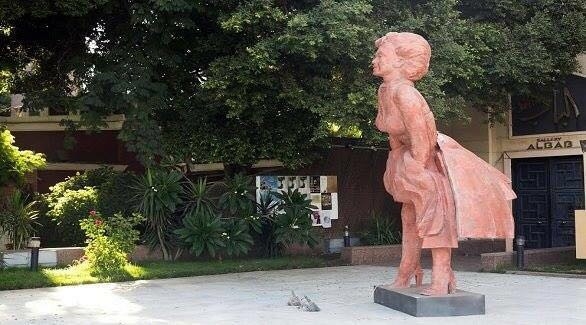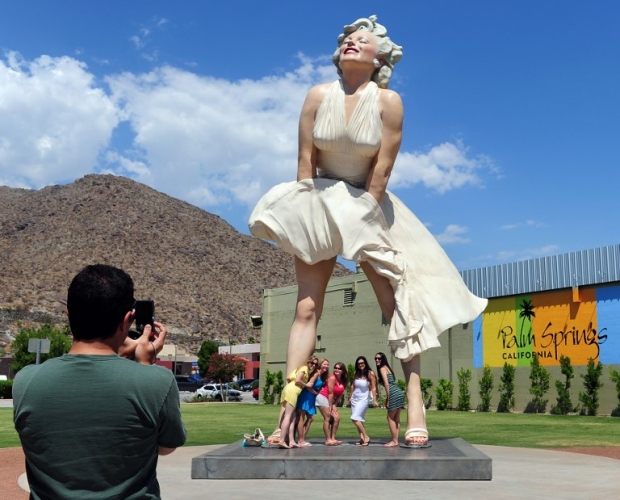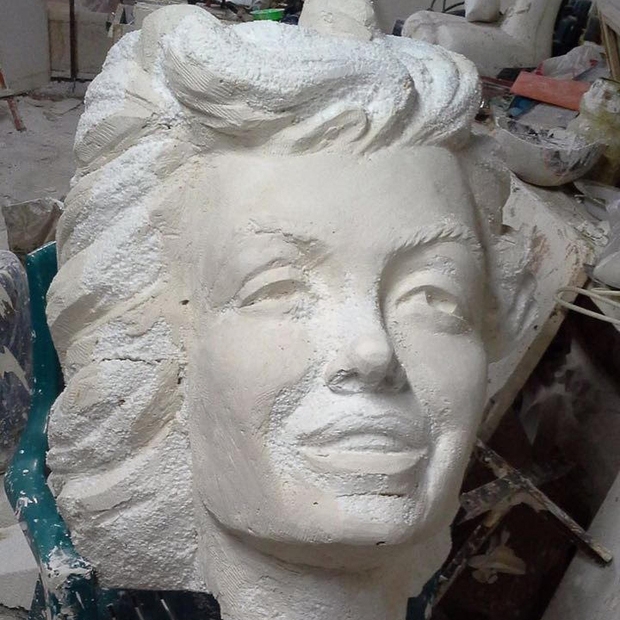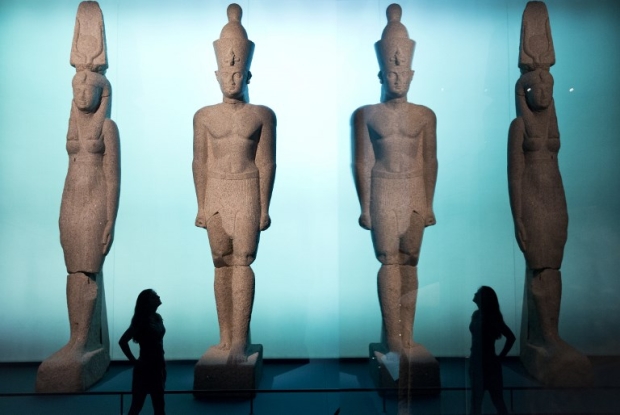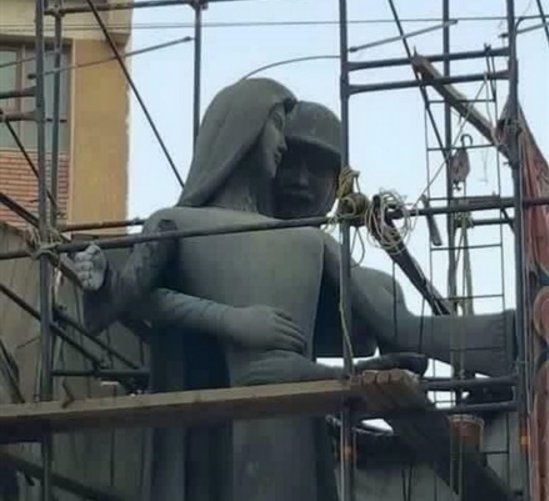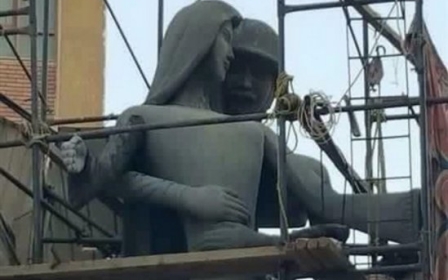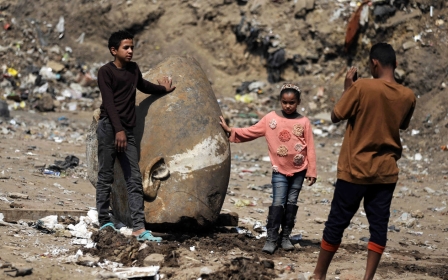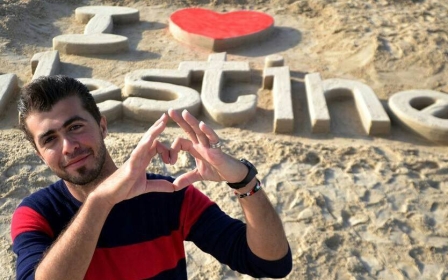Do Egyptians prefer blondes? Cairo's Marilyn Monroe statue sparks outcry
CAIRO - A statue of the late American actress Marilyn Monroe has sparked controversy in Egypt for being “ugly”, disproportionate and looking nothing like the blonde icon.
Last month, the statue created by Ehab al-Asyuti, head of the sculpture department at Minya University in Upper Egypt, was erected in Cairo’s Opera House as part of his exhibition.
The 7,000 EGP ($389) statue was intended to be a replica of the eight-metre-high statue in Chicago that has become a famous tourist attraction, with many rushing to take photos with the sculpture.
The original statue depicts Monroe attempting to push down her dress, as a gust of wind pushes it up as she stands over a subway grate. The famous image of Monroe is based on a scene from her 1955 Hollywood movie The Seven Year Itch.
Critics have taken to social media to heap scorn on the statue, saying it can't be compared with the original in Chicago.
Translation: The picture on the right represents the real statue of Marilyn, while the one on the left is Egyptian made at the Opera House. [It looks like] an ad for ointment used to treat rashes.
Translation: Egypt’s Opera House created a statue of Marilyn Monroe. It seems like the Egyptian Marilyn suffers from diabetes and the artist caught her while she was about to go to the bathroom.
Others said that the famous actress has been turning in her grave since the statue was revealed.
Translation: They are saying this is Marilyn Monroe’s statue in Egypt’s Opera House, if she sees it she’ll commit suicide again!
On the other hand, some questioned why the Cairo Opera House would showcase a statue of an American actress rather than an Egyptian one.
Translation: Why put a statue of Marilyn Monroe in the opera, why not put a statue of Umm Kulthum, Abdel Wahhab, Abdel Halim or any Egyptian musician who made a difference in our history.
Other social media users shared the artwork created by art students depicting statues of famous Arab actresses like the late comedy star Mary Moneib, saying it was much better than the Monroe statue.
No taste in art
Al-Asyuti was shocked by the reaction he received, saying that the main problem was with the audience rather than his artwork.
'Unfortunately Egyptians don't [have] taste in the art of sculpture and don't know how to evaluate it'
- Ehab al-Asyuti
"Unfortunately Egyptians don't [have] taste in the art of sculpture and don't know how to evaluate it," Al-Asyuti told MEE.
He did admit that there were “minor errors” in the finishing of the statue, "but I’m happy and satisfied with the final outcome,” he said.
Al-Asyuti also claimed that the campaign was personally targeting him and not just the statue.
"The campaign against the statue is exaggerated and is personally against me,” he said. “It's a big exhibition with 28 statues that lasted for 10 days. They left all the 28 statues and kept criticising the Marilyn Monroe statue.”
'The campaign against the statue is exaggerated and is personally against me'
- Ehab al-Asyuti
According to al-Asyuti, the four-metre-high statue was initially designed to be showcased at the entrance of a tourist village, but a few months later the owners retracted their request and did not pay him for the statue.
“So I decided to use it as a welcome statue in my exhibition,” he said.
"People are mocking the first four-metre-high statue in Egypt. This is progress in the art of sculpture in Egypt," he concluded.
Other artists and experts weighed in on the issue, saying that the sculpture offended Egyptian artists.
'We are the descendants of the pharaohs who are the pioneers in this field'
- Mohamed Labib, artist
Egypt's pharaohs created many magnificent statues that now adorn museums across the globe and continue to attract millions of visitors. In March, a statue of ancient Egypt's pharaoh Ramses the Great was found in the heavily populated suburb of Heliopolis.
"The Marilyn Monroe statue defames us, it defames the whole work of Egyptian sculptors," he said angrily.
Affaf Mostafa, public relations officer at an arts production company, said that she now enters the opera house from a different gate to avoid seeing the statue.
"The statue is really ugly and it distorts the fine image of Marilyn Monroe in our mind," she said. "I was shocked when I saw it. I was about to vomit, it's awful, really awful."
Mostafa, who visits the opera house regularly, said she was surprised that it had decided to showcase the statue.
Pointing fingers
In the wake of the outcry, the opera house has also distanced itself from the statue.
'The statue is really ugly and it distorts the fine image of Marilyn Monroe in our mind'
- Affaf Mostafa
Inas Abdel Dayem, director of the Cairo Opera House, told local media last month that the statue had nothing to do with the venue, saying that it was placed beside the entrance of al-Asyuti’s visual art exhibition. The exhibition was held under the auspices of the culture ministry’s visual arts department.
She added that the opera house is known for its beautiful and valuable works of sculpture, such as statues of famous Egyptian and Arab singers like Umm Kulthum, Abdel-Wahhab and Farid al-Atrash.
Statue backlash
Yet al-Asyuti's Monroe is only the latest in a number of statues that have been at the centre of criticism and ridicule from Egyptians.
In September, authorities ordered changes to a statue located in Martyr Square in the small town of Balyana, in the southern province of Sohag. It depicted an Egyptian soldier embracing a woman, often a symbol used to represent Egypt. Social media users were outraged, saying that it looked like a soldier sexually harassing a woman.
A cabinet official told AFP that the ban was imposed because of "the repeated setting up in the country's squares of bad statues that do not conform with Egypt's deep-rooted history".
The artist behind the sculpture, 60-year-old Wagih Hani, defended the work, telling the Associated Press news agency that the soldier represented the "spirit of the martyr" protecting Egypt. The statue was altered to show the woman holding up the Egyptian flag.
In 2015, a statue depicting Egypt's legendary beauty Queen Nefertiti was removed from the entrance of the city of Samalut in Minya after being compared to Frankenstein.
"Unfortunately our production is currently not good at all," said Labib.
An arts expert, who preferred to remain anonymous, said that the art of sculpture is not popular among the younger generation and faces many challenges.
"Good sculptors are so few and fewer students join the sculpture departments, so there is no fresh blood or [new] ideas," she said.
She said that creative young people have no motivation because of a lack of opportunity. "Even the few youth sculptors are not given the opportunity to have their exhibitions before the age of 40," she added.
Stay informed with MEE's newsletters
Sign up to get the latest alerts, insights and analysis, starting with Turkey Unpacked
Middle East Eye delivers independent and unrivalled coverage and analysis of the Middle East, North Africa and beyond. To learn more about republishing this content and the associated fees, please fill out this form. More about MEE can be found here.


